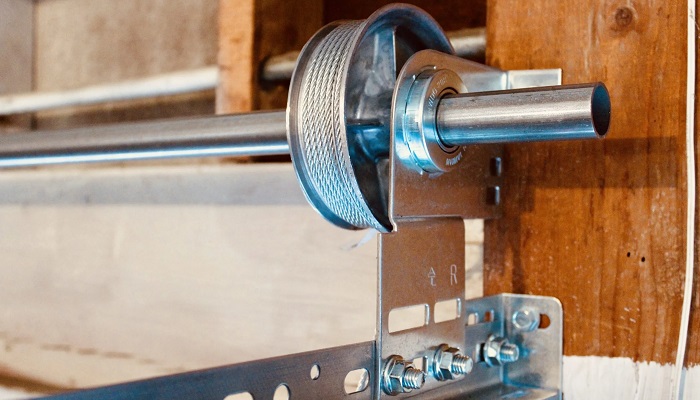To replace a garage door cable, start by securing the door in place and releasing the tension. Next, detach the old cable and attach the new one.
Replacing a garage door cable might seem daunting, but with the right tools and a methodical approach, it’s a task you can handle. Garage doors are integral to our homes, providing security and convenience. However, over time, the cables that help lift and lower the door can wear out or break.
This not only poses a safety risk but can also prevent the garage door from functioning properly. Understanding how to replace a garage door cable is a valuable skill for any homeowner. It saves time and money and ensures your garage door operates smoothly and safely. With a focus on safety and precision, you can restore your garage door to optimal condition.
Introduction To Garage Door Cable Replacement
A garage door is essential for home security. Like other mechanical parts, cables need attention. They lift and lower the door safely. Replacing garage door cables is vital for smooth operation. This guide outlines the process, ensuring your garage door works properly.
Importance Of Functional Cables
Garage door cables play a key role. They bear the door’s weight as it moves. Without them, doors can’t function. Cables also ensure safety. Broken cables can cause doors to fall. This guide explains the steps to replace them correctly.
Signs Of Wear And Tear
- Fraying: Look for unraveled strands on the cable.
- Loose cables: Cables should be taut. Loose ones may snap.
- Rust: Rust weakens cables. Check for any discoloration.
- Stuck door: A door that won’t move may have cable issues.

Credit: m.youtube.com
Safety First
Safety First stands paramount when undertaking any home repair task, especially when dealing with the heavy mechanisms of a garage door. Before venturing into the replacement of a garage door cable, it’s crucial to prioritize your safety to prevent accidents.
Tools And Precautions
Proper tools ensure a smooth and safe repair process. Gather the following:
- Wrenches
- Locking pliers
- Winding bars
- Gloves
- Safety glasses
Precautions are essential:
- Wear safety gear always.
- Keep children and pets away.
- Never remove the garage door springs or cables while under tension.
- Use sturdy ladders for height.
Power Disconnect
Before starting, disconnect the garage door opener. This ensures the door won’t be activated unexpectedly. Follow these steps:
- Unplug the opener from the power source.
- Engage the manual release lever.
- Secure the door with locking pliers above a roller.
With the power disconnected, you can safely proceed. Remember, tackling a garage door repair is risky. If unsure, seek professional help.
Understanding Garage Door Types
Before replacing a garage door cable, recognize your door type. Each has unique mechanisms. This knowledge ensures a smooth repair process. Let’s dive into the two common types.
Tilt-up Doors
Tilt-up doors move as a single solid piece. They pivot out and up, tilting into the garage. Below are key points:
- Single Panel: Made from one piece of material.
- Pivoting Hinges: These allow the door to tilt.
- Spring Assembly: Counterbalances the door weight.
Replacing cables on tilt-up doors requires caution. The spring tension is high. Always secure the door before starting.
Sectional Roll-up Doors
Sectional roll-up doors consist of panel sections. These sections are connected with hinges. As the door opens and closes, wheels at the edge of each panel roll inside a vertical track on each side of the door opening.
- Multiple Panels: Doors are sectional.
- Hinges and Rollers: Facilitate smooth motion.
- High-Tension Springs: Help in lifting the door.
Cable replacement on sectional doors involves managing the spring tension. Ensure the door is in the closed position to reduce tension.
Identifying your garage door type is crucial. It makes cable replacement safer and more effective.

Credit: www.greeleygaragedoorrepair.com
Preparation Steps
Before replacing a garage door cable, preparing is key. This guide covers the initial steps to ensure a smooth process. Follow these steps carefully for a safe and efficient cable replacement.
Gathering The Necessary Tools
Start by collecting all tools and materials needed. This prevents delays. A proper set of tools ensures a smooth repair. Below is a list of essential tools:
- Wrench set – For loosening and tightening nuts.
- Locking pliers – To secure the door in place.
- Wire cutters – For cutting the old cable.
- Cable – A new cable specific to your door type.
- Gloves – To protect your hands during the process.
Ensure all tools are in good condition before starting.
Securing The Door
Securing the garage door is crucial for safety. Follow these steps:
- Close the door fully. This provides a safe starting point.
- Use locking pliers above one of the rollers. This prevents the door from opening unexpectedly.
- Disconnect the door opener. This removes any automatic movement risk.
With the door secured, you’re ready to proceed safely.
Removing The Old Cable
Before installing a new garage door cable, removing the old one is crucial. This step ensures your garage door functions smoothly and safely. Let’s dive into how to remove the old cable effectively.
Releasing Tension
To safely remove the garage door cable, first, release the tension. This process involves careful steps to avoid any accidents. Here’s how:
- Close the garage door fully to ensure safety.
- Find the spring tension mechanism on your garage door.
- Using winding bars, slowly unwind the springs to release tension.
- Ensure the springs are fully relaxed before proceeding.
Detaching The Cable
With the tension released, you can now detach the old cable. Follow these steps:
- Locate the cable drum at the top of the door.
- Loosen the set screws on the drum with a wrench.
- Gently unwind the cable from the drum.
- Detach the cable from the bottom bracket on the door.
- Remove the old cable completely and prepare for the new installation.
Remember, safety is paramount. Wear protective gloves and goggles during this process. Following these steps carefully will ensure a smooth transition to installing your new garage door cable.
Installing The New Cable
Ready to tackle your garage door cable replacement? Let’s dive into the installation of the new cable. This guide will walk you through the process step-by-step, ensuring your garage door is back to peak performance in no time.
Threading The Cable
Begin by threading the new cable. Follow these steps:
- Open the garage door fully.
- Lock it in place for safety.
- Locate the cable drum on the door’s bottom corner.
- Thread the cable through the rollers.
- Ensure the path is straight and clear.
Attaching To The Drum
Next, attach the cable to the drum. Keep these points in mind:
- Find the drum’s attachment slot.
- Insert the cable end into this slot.
- Wrap the cable around the drum.
- Align it properly in the grooves.
- Tighten the set screws firmly.
With these steps, your garage door cable is now securely installed. Test the door’s movement to ensure smooth operation.
Tension Adjustment
Adjusting your garage door cable tension is key for smooth operation. Correct tension ensures safety and efficiency. This guide will help you set the right tension and test the door balance. Follow these steps for a well-functioning garage door.
Setting Correct Tension
To set the correct tension, first, close the door. Ensure cables are taut but not overly tight. Loosen the set screws on the drum. Turn the drum to tighten or loosen the cable. Aim for slight resistance when lifting the door manually. Secure the set screws once the tension feels right.
Testing The Door Balance
Testing balance is crucial after tension adjustment. Disconnect the opener and lift the door halfway. A well-balanced door stays in place. If it falls or rises, tension needs fine-tuning. Repeat tension adjustment steps until the door remains still when left halfway open.
Note: Always handle garage door components with care. Wear safety gear. For complex issues, seek professional help.
Final Checks And Maintenance Tips
After successfully replacing your garage door cable, it’s crucial to perform final checks. Proper maintenance ensures lasting performance and safety. Let’s dive into essential after-care tips.
Lubrication And Cleaning
Post-replacement, lubrication keeps your garage door running smoothly. Use silicone-based lubricants on cables and springs. Apply sparingly to avoid attracting dirt. For cleaning, wipe down cables with a damp cloth. Remove debris and grime to prevent wear. Keep tracks and rollers free of obstructions. This prevents future malfunctions.
Regular Inspection Schedule
Set a schedule for routine inspections. This proactive approach catches issues early. Inspect cables, springs, and hardware monthly. Look for signs of wear, fraying, or corrosion. Tighten any loose bolts and nuts. Replace worn parts promptly. This extends your garage door’s lifespan.
- Check balance by lifting the door halfway. It should stay in place.
- Test safety features like auto-reverse and sensors.
- Ensure the door opens and closes without jerking or stalling.
Maintain your garage door with these tips. Your door will operate safely and efficiently for years.
Troubleshooting Common Issues
Encountering issues with a garage door can be frustrating. Proper troubleshooting is key to fixing problems quickly. This guide focuses on common issues with garage door cables.
Door Not Level
A door not level often indicates a cable problem. Check for these signs:
- Uneven gaps between the door and ground.
- Door hangs lower on one side.
To fix, ensure cables are wound evenly on the drums. Adjust if necessary.
Cable Slippage
Cable slippage leads to door malfunction. Look out for:
- Loose cables on the sides.
- Door stops or jerks during movement.
Tighten loose cables to resolve slippage. Replace if worn or damaged.
Remember, safety first. Turn off power and use proper tools.
When To Call A Professional
Knowing when to call a professional is key in garage door repairs. Sometimes, it’s best to leave complex tasks to the experts. This is especially true for replacing garage door cables.
Complex Repairs
Garage door cable replacement might seem straightforward, but it’s often complicated. The cables are part of a system that includes springs, drums, and other components. If you’re not familiar with these, you could risk further damage. Professionals have the tools and know-how. They ensure the job gets done right and the door operates smoothly.
Safety Concerns
Safety should always come first with DIY projects. Garage doors are heavy and under high tension. One wrong move can lead to injury. Experts have the correct safety gear and training. They handle high-tension cables safely. If you’re not confident in managing these risks, call a pro. It’s the best way to ensure your safety and that of your family.

Credit: www.youtube.com
Frequently Asked Questions
What Is A Garage Door Cable?
A garage door cable is a steel wire rope that connects the garage door to the counterbalance system, aiding in the smooth opening and closing of the door.
How Often Should Cables Be Replaced?
Garage door cables should generally be inspected annually and replaced if they show signs of wear, fraying, or corrosion to ensure safety and proper function.
Can I Replace Garage Door Cables Myself?
While it’s possible to replace garage door cables yourself, it requires understanding of the garage door mechanism and extreme caution due to the high tension involved. Professional assistance is recommended for safety.
What Tools Are Needed For Cable Replacement?
To replace a garage door cable, you’ll need locking pliers, a winding bar, wrenches, and a ladder. Always ensure tools are suitable for the specific garage door system.
How Much Does Cable Replacement Cost?
The cost for replacing a garage door cable can vary, typically ranging from $150 to $200, depending on the complexity of the job and whether you hire a professional or do it yourself.
Conclusion
Replacing a garage door cable can seem daunting, but with the right tools and guidance, it’s a task you can tackle confidently. Remember to prioritize safety and double-check each step to ensure your garage door functions smoothly. Ready to embrace the challenge?
Your garage door awaits its refreshed and reliable operation.





